
Rediscovering Japan

Rediscovering Japan
Travel (Nikko (Part 1) (Nikko/Rinnouji/Toushouguu))

by tomizuta
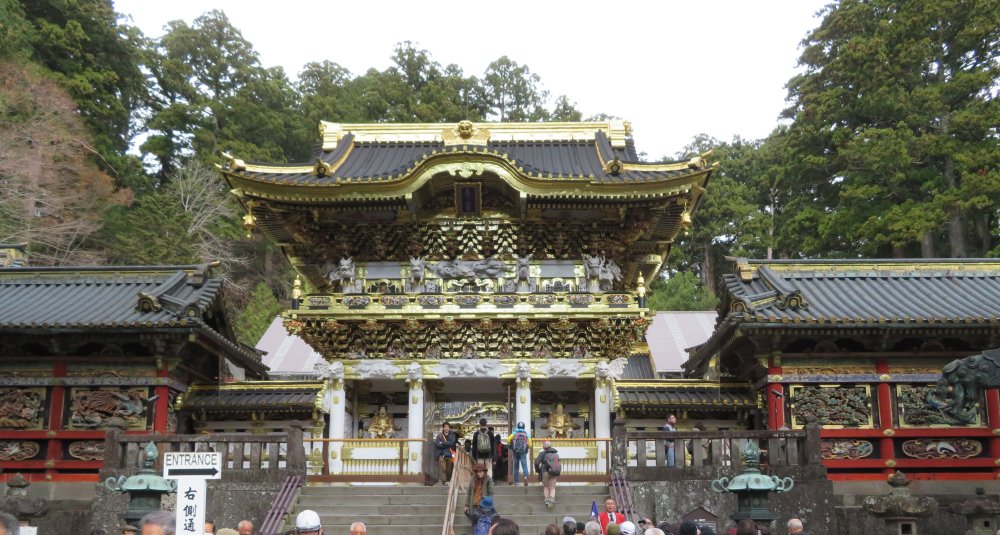
The grand Youmeimon Gate of Toushouguu Shrine.
There is a saying in Japan, “Don’t say kekkou (splendid) before you have seen Nikko.” Nikko has certainly been one of the most popular tourist spots in Japan. Toushouguu Shrine, Futarasan Shinto Shrine, Rinnouji Buddhist Temple and the surrounding areas were designated as a World Cultural Heritage site in 1999, but I hadn’t visited the place for over twenty years. Having recently re-explored Kamakura and viewed the Tokugawa mausoleum relocated to Kenchouji Temple and visited Zoujouji Temple in Minato Ward, Tokyo, where some gates and monuments of the Tokugawa mausoleums that survived the bombings of WWII can be seen, I felt that I needed to revisit Nikko that houses the two grand mausoleums of the first and third Tokugawa shouguns. Nikko is located about 150 kilometers from the Tokyo area. We left about 9am to arrive at Nikko 2pm after having had lunch in Utsunomiya. We first visited two popular tourist sites further up in the mountains from central Nikko, the Kegon Waterfall and Lake Chuuzenji.
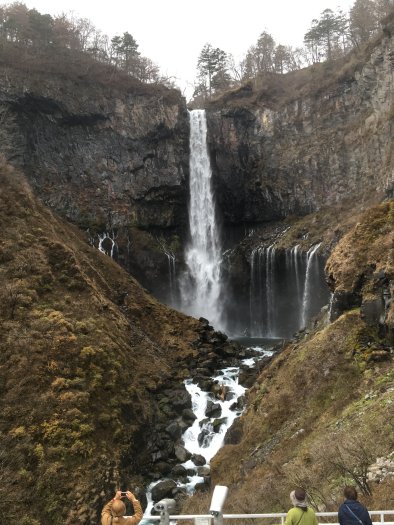
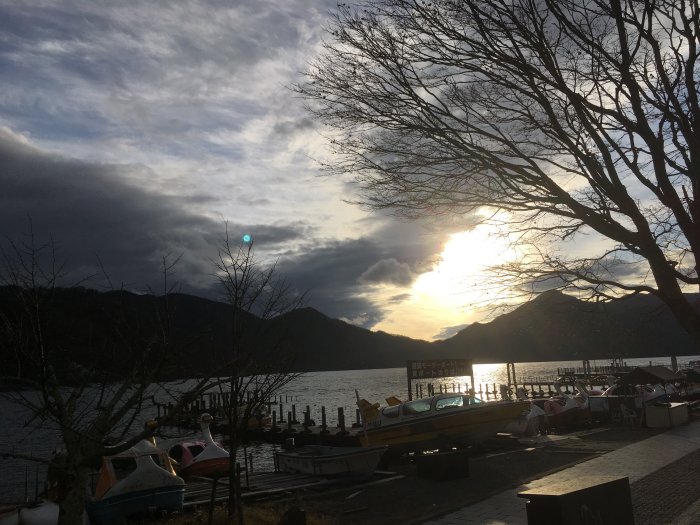
Kegon Waterfalls (left) and Lake Chuuzenji at sunset (right).
We left Chuuzenji for our hotel in Nikko, the Nikko Kanaya Hotel, which is one of the oldest western style classic hotels in Japan that commenced the hotel business in 1873, five years after the Meiji Restoration. I learned that the business started as Kanaya Cottage on a site closer to the shrines and temple, as a hotel solely for foreigners(the four hundred year old former samurai residence is now open to the public as the Kanaya Hotel History Museum) which expanded by the acquisition and completion of the current main hotel building in 1893.
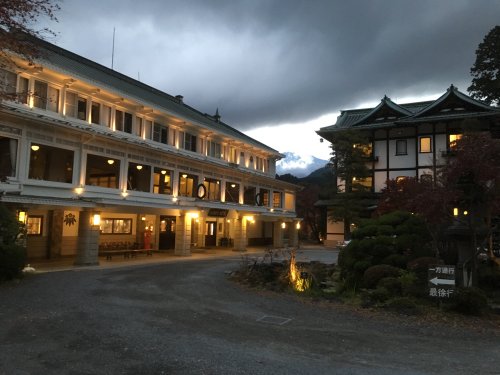
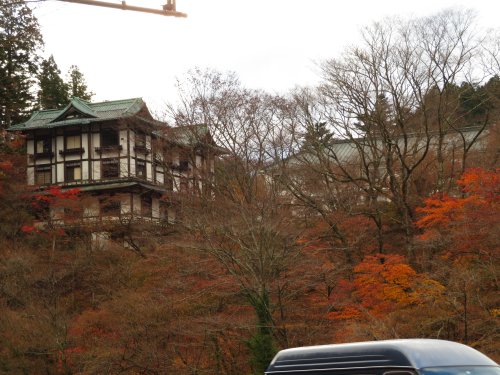
The Kanaya Hotel after light up (left) and from across Daiya River (right).
Until the Meiji restoration, when all feudal domains were abolished, travel was very much restricted. People could not travel outside the feudal domain they lived in without permission. Rare exceptions were pilgrimage visits to Ise Jinguu Shinto Shrine called Oisemairi, where representatives of commoners would attend as a group. Although travel restrictions were lifted after the abolishment of the feudal domains, real development for travel had to wait for the development of the railways. Foreigners had to live in designated areas and travel beyond forty kilometers was forbidden without permission. This restriction remained even after the Meiji Restoration and was not lifted until the end of the 19th century. So it was a surprise for me that Kanaya Cottage for foreign travelers had opened so early. I understand from the hotel’s old mail magazine that this happened through the friendship between Zen-ichirou Kanaya, the founder of the hotel and Dr. James Hepburn, an American physician who resided in Japan from the end of the Edo period (1859) to 1892 in the Meiji era, and invented the Hepburn romanization system to transliterate Japanese into English and later founded Meiji Gakuin University. The mail magazine tells me that Zen-ichirou started Kanaya Cottage in 1873 based on Dr. Hepburn’s prediction that more and more foreigners would come to Nikko. Dr. Hepburn visited the cottage every summer with and introduced Nikko to many foreigners including Isabella Bird, the British lady traveler who wrote “The Unbeaten Tracks in Japan”. We stayed in the shinkan (new building) built in 1901, which I found quite acceptable. We spent a while to explore the lobby and the displays in the corridors. We enjoyed the dinner course menu and the breakfast in their antique dining room.
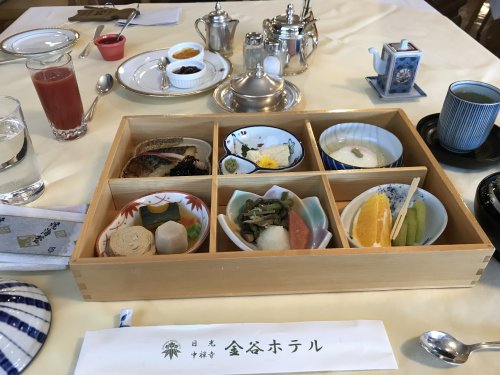
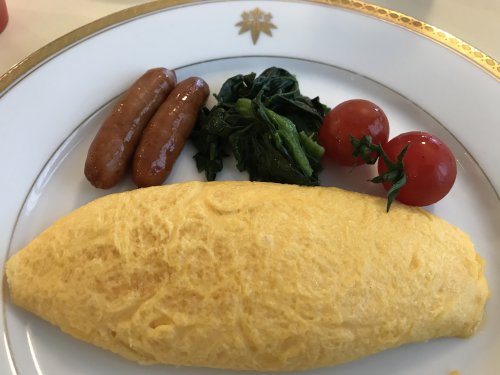
Breakfast at Kanaya Hotel. You have a choice of Japanese bentou box (left) and their famed omelette (right).
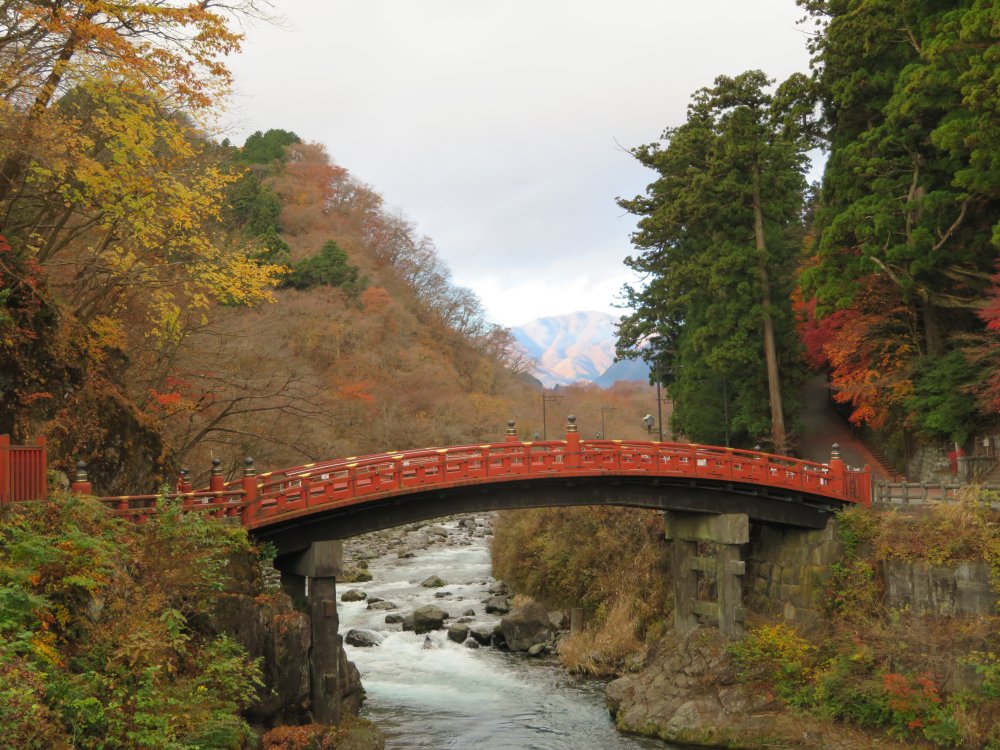
The Shinkyou (God's Bridge). There is a legend that when the high priest Shoudou came to River Daiya, two serpents entangled themselves to create a bridge for him. The bridge was modernized to its current state with stone piers in 1636. The current bridge was reconstructed in its original form in 1904 after it was swept way by a flood.
We first visited Rinnouji Temple. The history of Rinnouji can be traced
back to the 8th century, when the Buddhist high priest Shoudou founded
a temple called Shihonryuuji. I understand further temple buildings were
added in the 9th century. The temple enjoyed the patronage of the Kamakura
military government and flourished until the late 16th century, when Hideyoshi
Toyotomi confiscated the temple’s vast properties for supporting his opponent.
The temple started to prosper under the Tendai high priest Tenkai, who
was revered by the Tokugawa family. He initiated the construction of Toushouguu
Shintou shrine to worship Ieyasu Tokugawa, the founder, as a deity. In
1653, Taiyuuin was constructed as the mausoleum of the third Tokugawa shougun,
Iemitsu, and shortly thereafter the temple name of Rinnouji was bestowed
by the Emperor. As noted above, Rinnouji and the two Shintou shrines, Futarasan-jinja
and Toushouguu were organized as one religious complex until the Meiji Restoration
after which they were divided into three separate entities. That is the
reason Rinnouji’s temples are scattered in the Nikkou City area (The Yakushidou
in Toushouguu where you will see the Nakiryuu (crying dragon) is part of
Rinnouji, so is the Taiyuuin mausoleum on the other side of Toushouguu
and Futarasanjinja) as well as around the much higher Lake Chuuzenji area.
The main temple building Sanbutsudou is undergoing a major refurbishment
and we could only go around the area. Sanbutsudou, which is a World Heritage
designation component, was reconstructed by the third shougun Iemitsu in
1645.
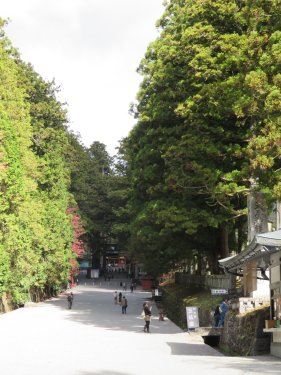
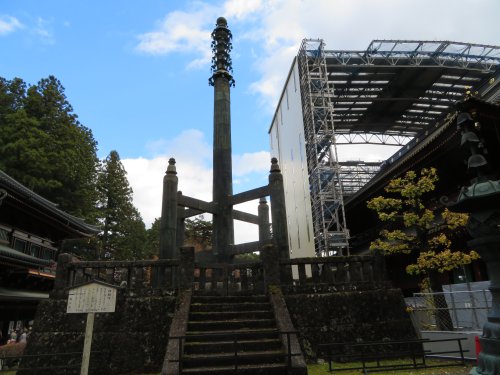
The approach to Toushouguu from the Shinkyou side. Rinnouji Temple is on the near right (left). The main building Sanbutsudou was undergoing major refurbishment (right).
We went past Sanbutsudou to come to a grand modern temple building, Daigomadou, where Goma prayers take place three times a day. Goma prayers are to pray to Buddha in front of a fire to expel earthly desires and wish for peace. Next to Daigomadou on the right is a modest building called Gohoutendou from the 17th century, thought to be the oldest building in Rinnouji. This is where the prayers took place before the construction of the modern building.
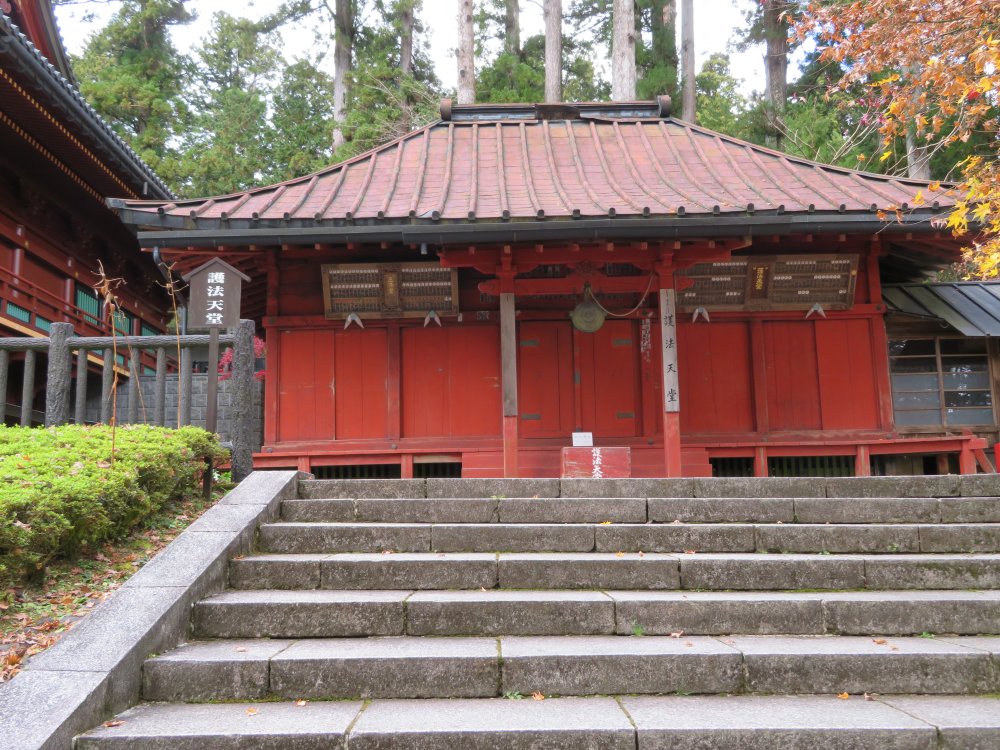
Don't forget to pay a visit to the Gohoutendou, believed to be the oldest building in Nikko, sitting peacefully next to the modern Daigomadou.
In front of the Gomadou on an elevated level stands the Sourintou. The explanation at the bottom tells us that this is a 15 meter high bronze pole erected by the high priest Tenkai in 1643 to pray for peace in the country under request of Iemitsu. A thousand Buddhist scriptures are contained inside the pole.
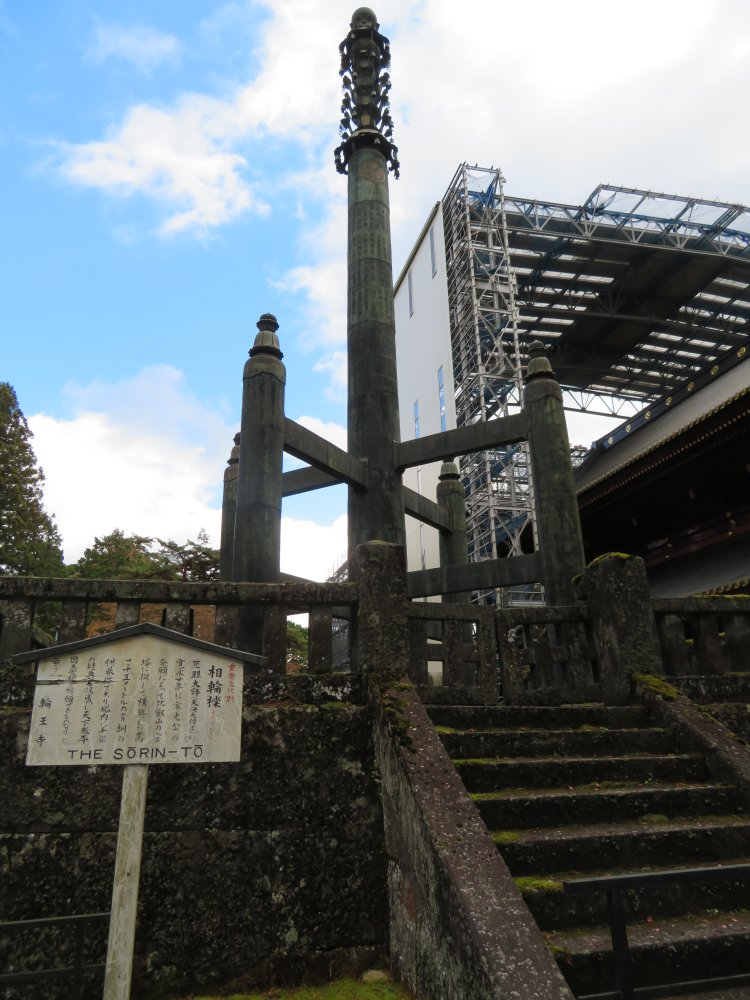
The explanation at the bottom tells us that the Sourintou is a 15 meter high bronze pole erected by the high priest Tenkai in 1643 to pray for peace in the country under request of Iemitsu.
We next visited the Toushouguu. It is a Shintou shrine dedicated to Ieyasu, originally one year after his death in 1618 by his son Hidetada. It was expanded in 1636 by Ieyasu’s grandson, Iemitsu in 1636 and is composed of 55 buildings according to Toushouguu’s website. I’ve visited Toushouguu several times but this was the first time I set out to seriously explore Nikko. I am ashamed to confess that I had always just visited the fabulous Youmeimon gate and taken a look at the three famous monkeys. There’s so much to see at Toushouguu. I will just talk about the highlights.
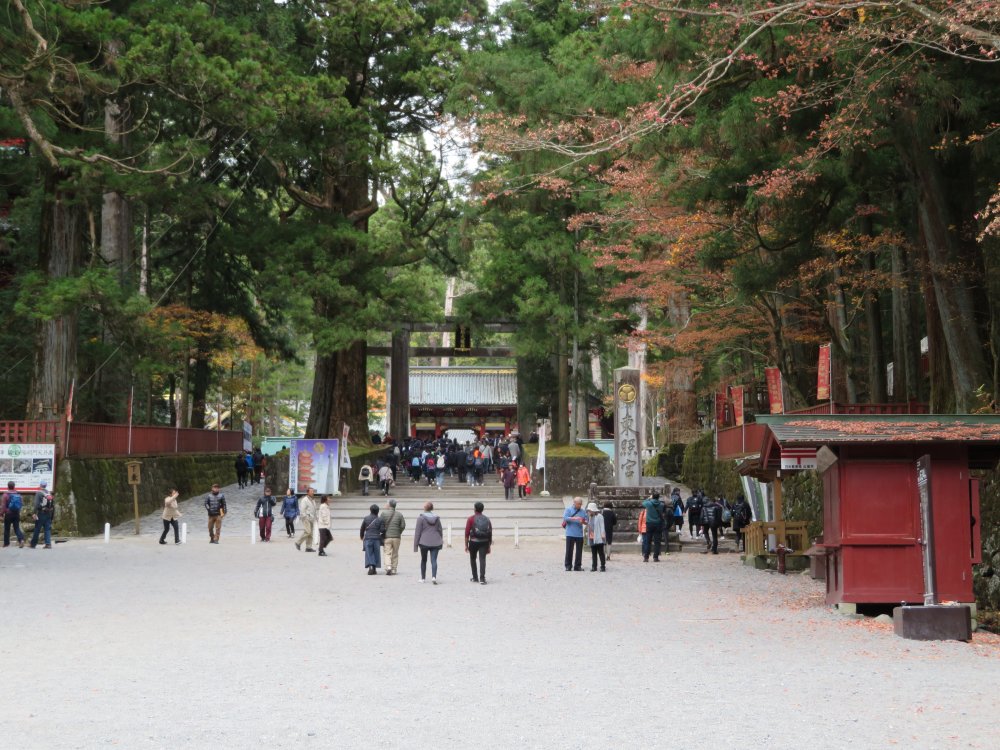
We went up the main path to Toushouguu. Although it was a weekday morning, there were quite a few visitors already.
Although it was a weekday, there were quite a few visitors to Toushouguu. I take it that many visitors or tours just visit Toushouguu and do not spend much time, if at all to visit Futarasan-jinja or Rinnouji, like I used to in the past. We went through the grand torii gate to come to the ticketing area. You can buy an entry ticket to Toushouguu alone for 1,300 yen or a combined ticket with the Toushouguu Museum for 2,100yen. I bought the combined ticket, but for overseas visitors, perhaps it’s better that you skip the museum and spend more time exploring Rinnouji and Futarasan-jinja. Although even the Toushouguu only admission fee seems expensive I found that it can be more than justified if you take a thorough tour of the shrine.
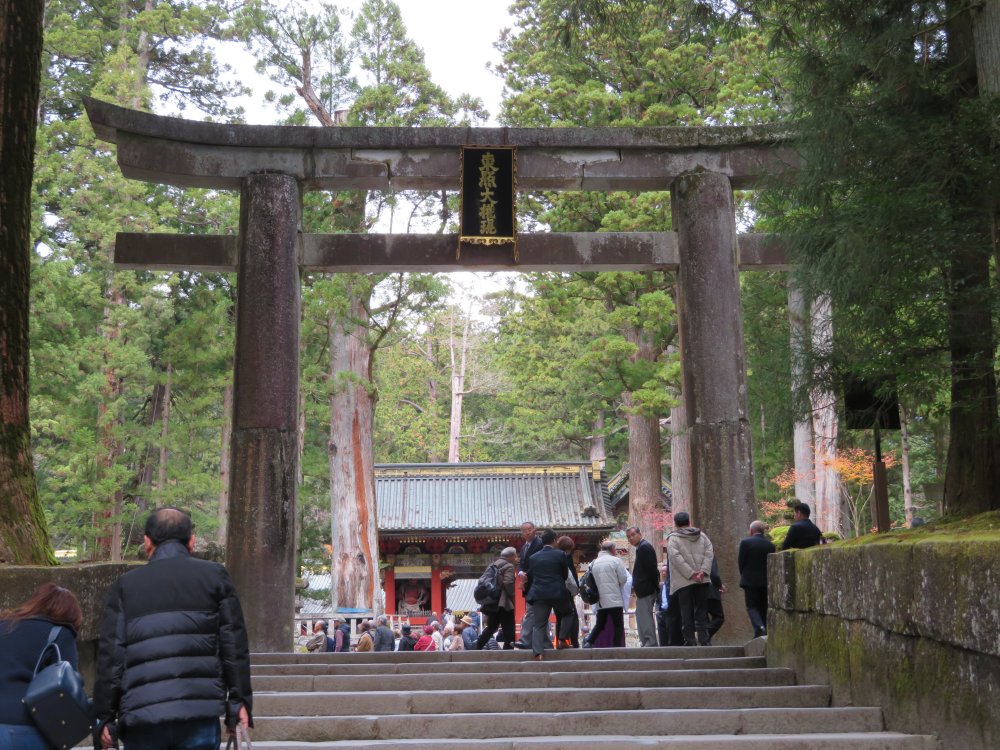
This torii is called Ishitorii (meaning made of stone). It is one of the largest torii gates in Japan and was contributed by Nagamasa Kuroda, the feudal lord of Fukuoka. The torii is made up of fifteen granite blocks brought from Fukuoka, a thousand kilometers away.
We went through the entrance gate. Two ogre-like figures greets visitors on both sides of the gate. The ogres are called Niou, so this entry gate (Omotemon) is also called Nioumon. Niou is a Buddhist figure, so it is a rare case that this Nioumon is the entry gate to Toushouguu, a Shintou shrine. I understand from the website of Toushouguu that for this reason the two Nious were transferred to Rinnouji under the rigid segregation policy of Buddhism and Shinto of the Meiji Government but eventually was returned to this gate.
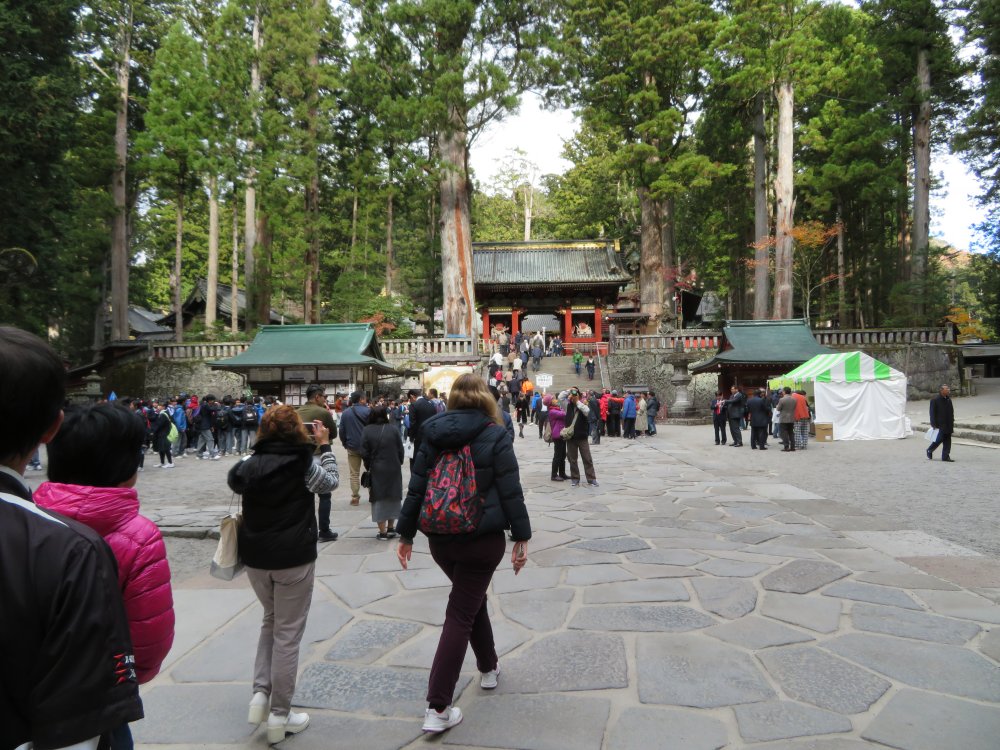
The Nioumon in the far rear and the ticket booth in front of the steps on the left.
We turned left to view the three monkeys called don’t see (mizaru), don’t hear (kikazaru) and don’t say (iwazaru) in the Shinkyuusha (stable for two sacred live horses for the deity to mount). There was quite a large crowd in front of the Shinkyuusha
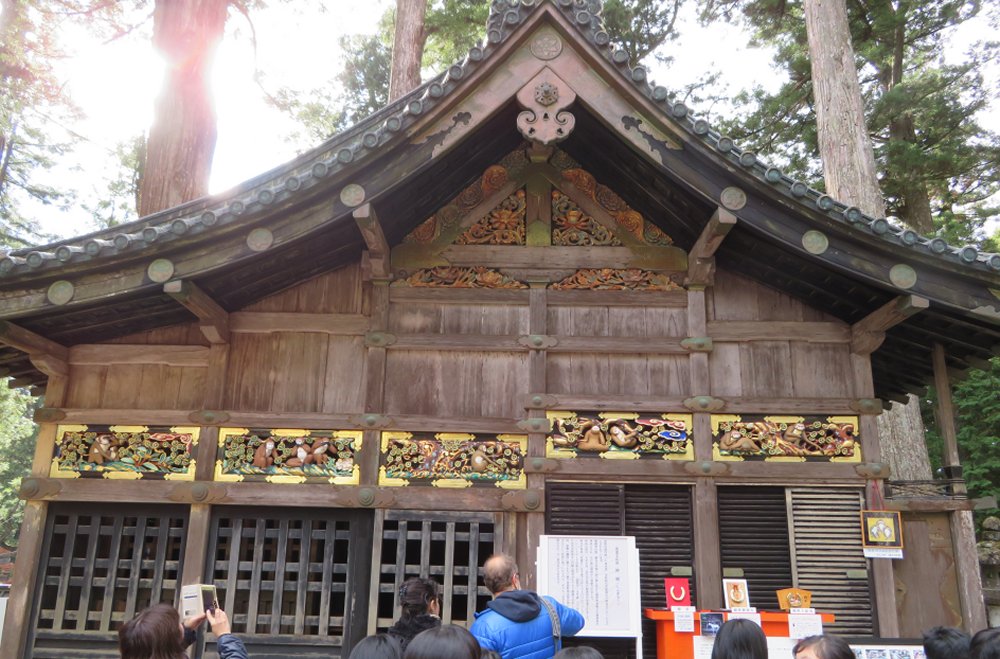
There was quite a large crowd in front of the Shinkyuusha. The famous three monkeys are on the second frame from the left.
The path swerves to the right to come to the entrance to the main shrine area. Before the gate, there is the Omizuya, where visitors washed their hands and mouth to purify themselves before entering the main shrine area. This was contributed by the feudal lord of Saga in Kyuushuu. Next to it was a 17th century revolving lantern from the Dutch Government.
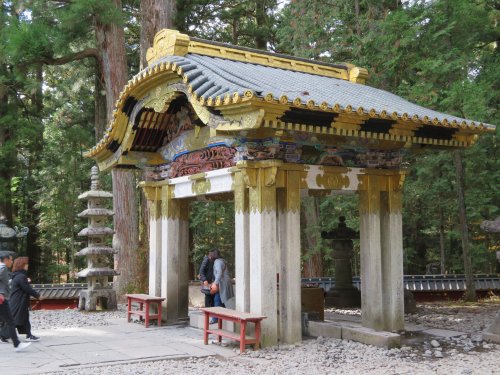
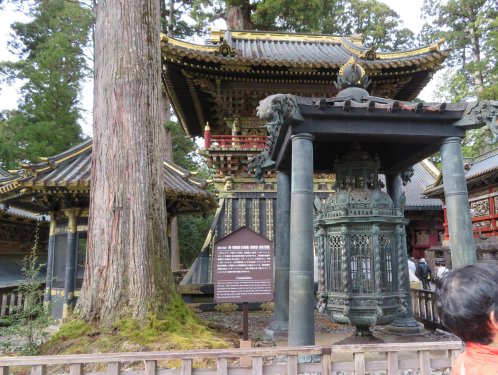
The Omizuya (left) and the revolving lantern from the Dutch Government (right).
On the right hand side next to the Sanjinko (three warehouses storing horse gear and parade costumes) were two steel lanterns contributed by the feudal lord of Sendai feudal domain. The nearby description tells that there are 121 lanterns contributed by feudal lords all placed before the Youmeimon Gate, with one exception of a lantern contributed by Toufukumon-in, Ieyasu’s granddaughter married to the Emperor Gomizunoo.
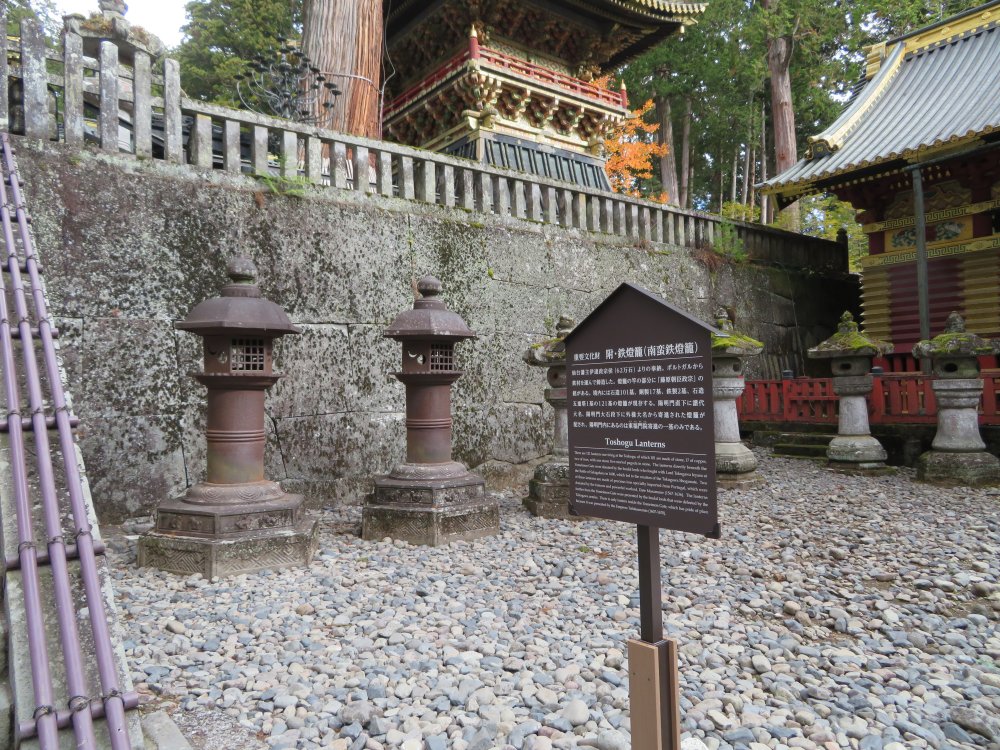
The two steel lanterns contributed by the feudal lord of Sendai feudal domain.
We went up the steps to reach the famous Youmeimon Gate. The name Youmeimon was taken from one of the gates of the Imperial Court in Kyoto. There is so much literature on Youmeimon. Suffice it to say that it is regarded as one of the grandest gates in Japan, embroidered with over five hundred figures from folklore and saints and sages, using the highest technique of the early Edo period and by master builders and artists. So grand is the gate that it is also called Higurashinomon (the all-day gate) as one could stay and marvel at the gate from dawn to sunset.
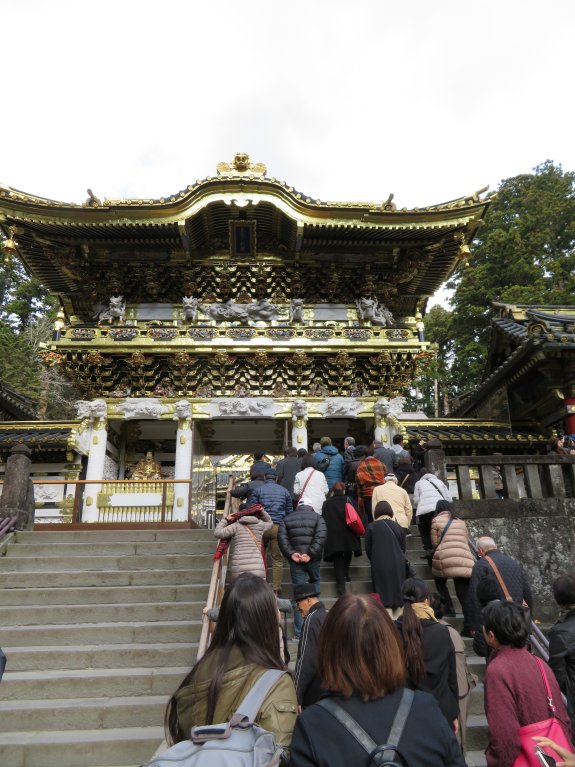
So grand is the gate that it is also called Higurashinomon (the all-day gate) as one could stay and marvel at the gate from dawn to sunset.
We entered the main shrine area. Directly opposite Youmeimon is another grand gate, Karamon (Chinese Gate) which is the entrance to the main shrine. You can find Karamons in many places, such as Nishihonganji Buddhist Temple in Kyoto. Only nobles of the highest rank could go through this gate to the praying room. On the event of a visit by the shougun to Toushouguu, many feudal lords accompanied him to enter the Karamon.
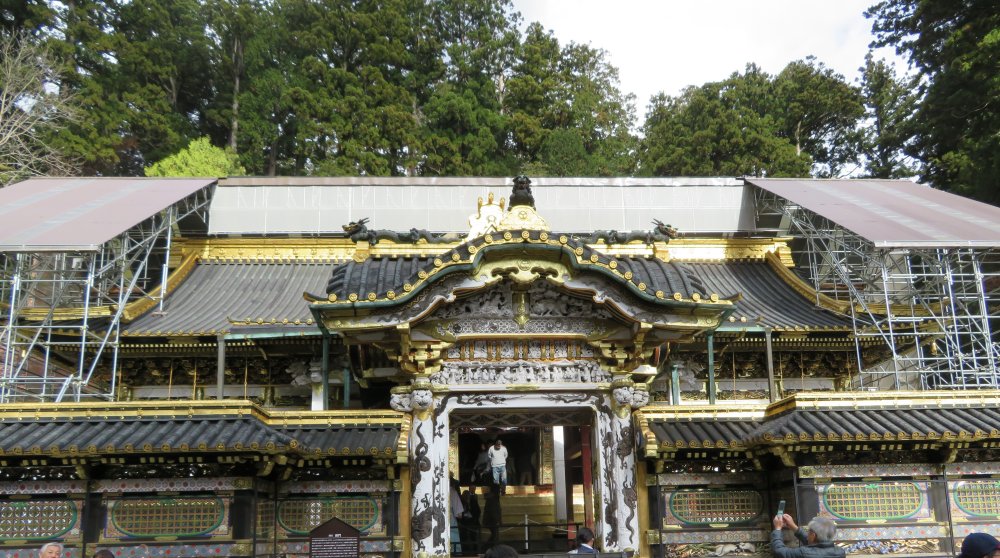
The Karamon. Only nobles of the highest rank could go through this gate to the praying room.
Before visiting the main shrine, we went to the right past the Kaguraden and Kitouden to see the Nemurineko (sleeping cat). This is a sculpture of a cat sleeping peacefully said to be by Jingorou Higashi, a master sculptor. The Nemurineko is on the gateway to Ieyasu’s grave in the back mountain. Don’t forget to turn around to see the other side of the Nemurineko with two sparrows. Some say that sparrows and the cat side by side depicts a wish for peace. Others say that the cat is protecting Ieyasu’s grave and is ready to pounce on invaders.
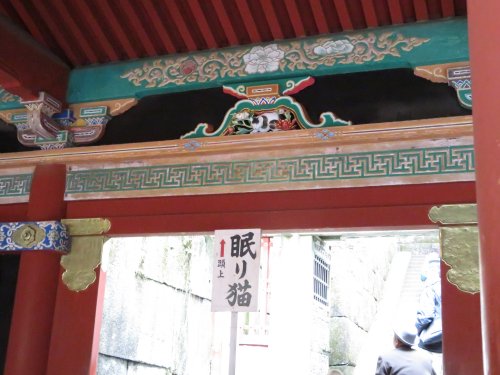
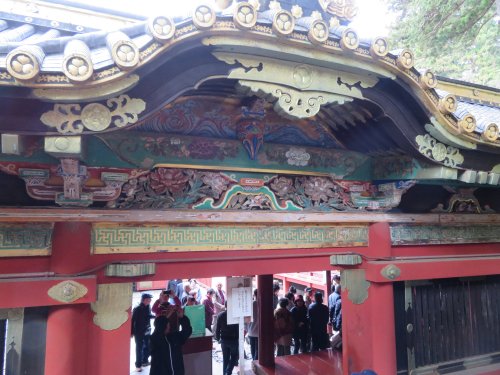
The sleeping cat (left) and the sparrows on the other side (right).
We went up to Ieyasu’s mausoleum. Less than a hundred steps up, we reached the top to find the inner praying shrine (Haiden), which is a modest building compared with the main shrine. I assume only the shougun family was allowed to come this far. Behind the Haiden is an entrance gate called Inukimon and a grave tower that you can walk around from a distance.
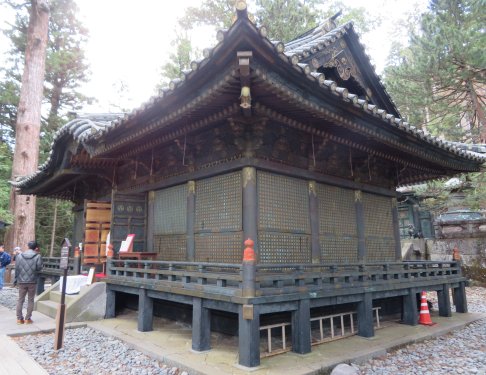
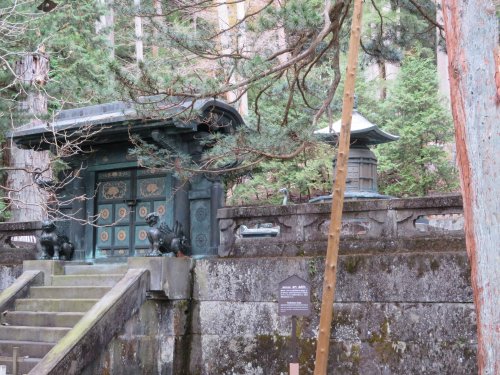
The modest Haiden (praying shrine) (left) and the Inukimon entrance gate to Ieyasu's grave and the grave tower behind (right).
We went back to the main shrine area. We took a look at the Kitouden (prayer shrine). This is a Buddhism style building built in 1635. It was spared from demolition under the Meiji Restoration by declaring the building was an administration office, I understand. This is where wedding ceremonies and other rituals are conducted to this day.
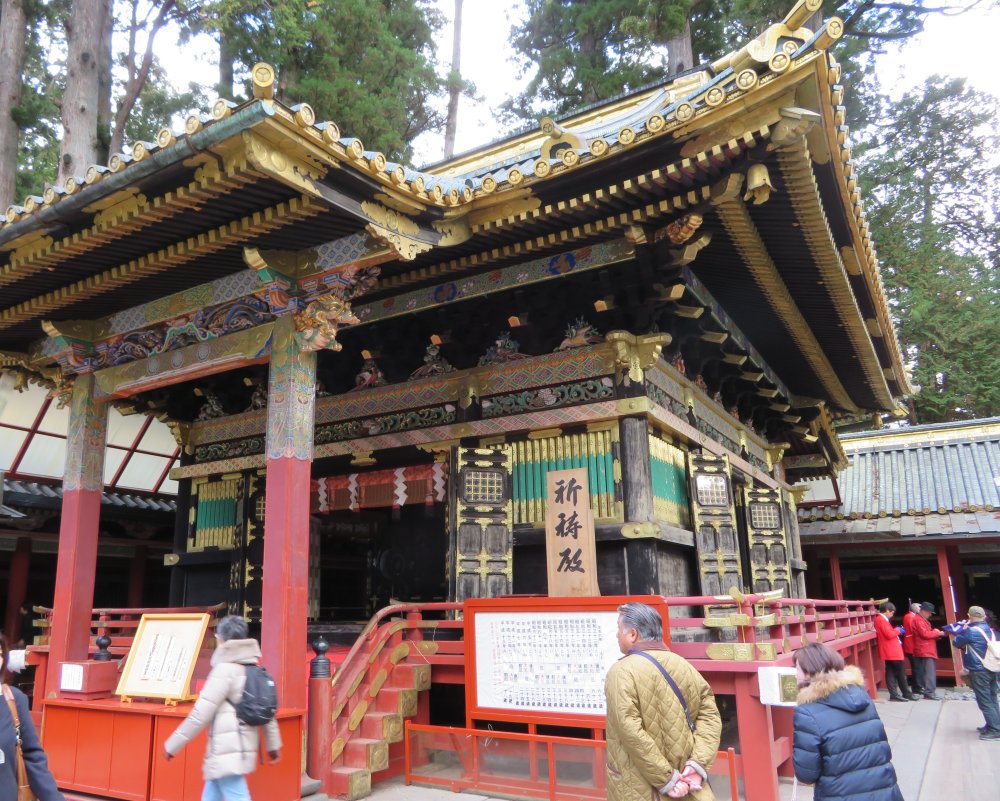
The Kitouden where wedding ceremonies and other rituals are conducted to this day.
The finale of our tour to Toushouguu was the main shrine which we entered from the east by the Kitouden. The main shrine is composed of in order from the Karamon entrance, the Haiden (praying area), the Ishinoma and the Honden (main shrine). Visitors are only allowed in the Haiden, which is composed of a sixteen hundred square meters vast tatami room, with a segregate area on both sides, one for the shougun and one for High Priest, and the Ishinoma. The Ishinoma connects the Haiden (our world) and Honden (the other world). All the feudal lords sat in the Haiden to pay their respects. This row of Haiden and Honden with the Ishinoma (or Ainoma) linking the two buildings is known as Gonden style. It is a rare opportunity to be able to visit the inside of a main Shinto building. No photography is allowed however.
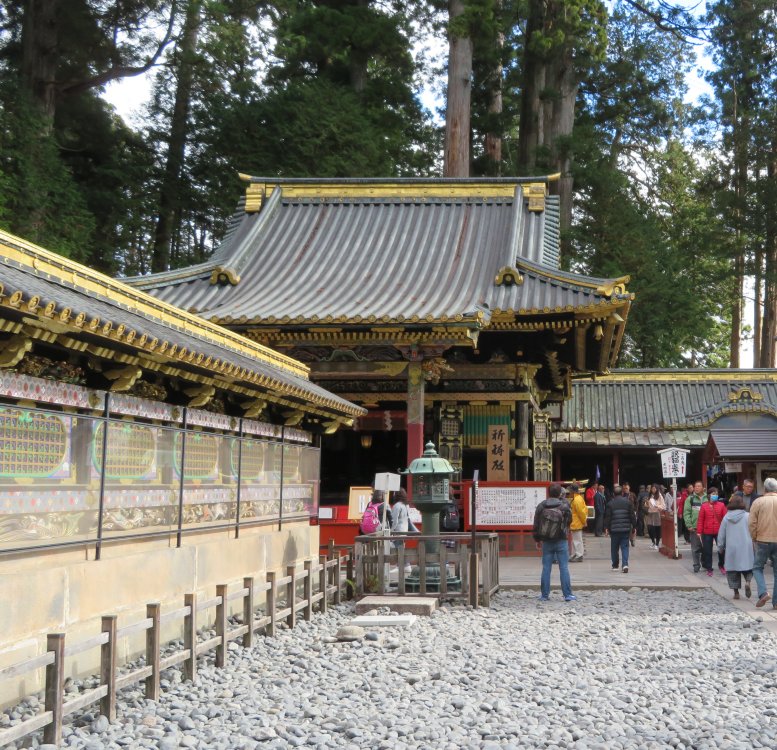
The magnificent sidewalls of the Honden. Visitors enter from the left of the lantern.
We came out of the main shrine building, through the Youmeimon and back to the stone torii gate next to the Toushouguu Treasure Museum, we noticed another building, the Okariden (temporary shrine). Karidens are temporary shrines to house the deity while the main shrine is being refurbished. They are temporary buildings and are demolished after the refurbishment. Toushouguu is an exception where the Okariden built in 1639 has been kept to this day. This has also been constructed in the Gongen style with the Honden linked to the Haiden by an Ainoma. We completed our tour of Toushouguu shrine.

You shouldn't miss the Okariden built in 1639 and kept to this day.